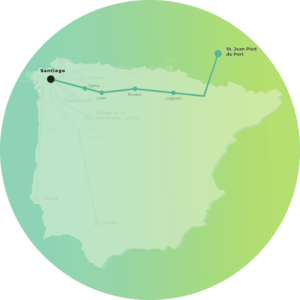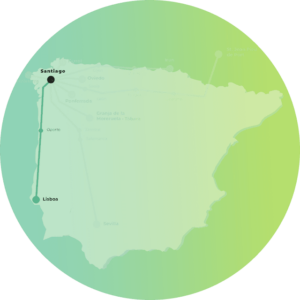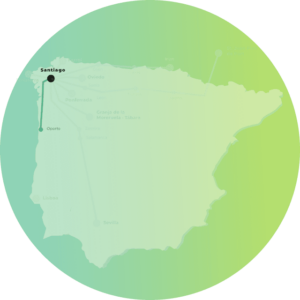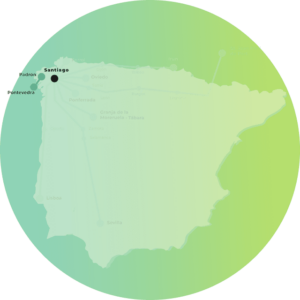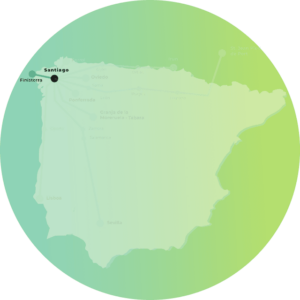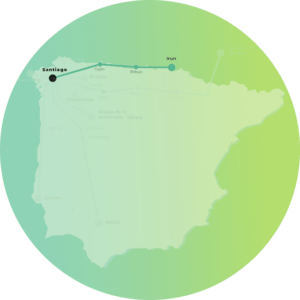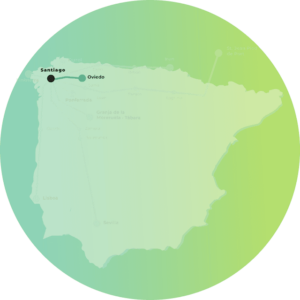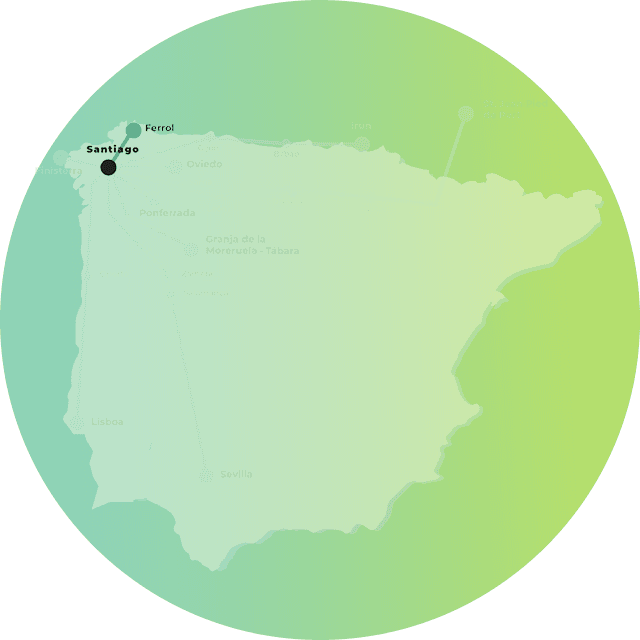Fully Organized Camino de Santiago Tours
We offer a wide variety of organized trips along all the Routes of the Camino de Santiago. You can experience walking the Camino in a group, on your own, with your dog or by bike, and enjoy amazing excursions around Galicia. Easy, comfortable, and with the peace of mind of being in the best hands.
We are a Travel Agency exclusively dedicated to organizing experiences along the Camino de Santiago routes. Our team, based in Santiago de Compostela just a few meters from the Cathedral, is made up of Official Guides and Travel Agents specialized in the Camino de Santiago.
Our Services
As a Camino de Santiago agency, we offer you all our experience to provide the best services throughout your pilgrimage. Because we know your time is precious, we put all our experts at your disposal to make your journey unforgettable and truly unique.
All you need to do is enjoy the simple pleasure of walking.
Luggage transport
We transfer your luggage from one lodging to another so that you can make The Camino comfortably.
Meals
Add breakfast or half board to your trip and follow our recommendations for bars and restaurants.
Practical information
You will receive a detailed guide with stage information and incredible recommendations.
Private transfers
Wide network of vehicles to take you to the beginning of your Camino or to any other point you need.
Some Frequently Asked Questions
You don’t need to be an athlete to do the Camino de Santiago, but we recommend getting used to walking and training in the weeks prior with walks and mentally preparing yourself.
The Camino de Santiago in Galicia can be started from various points depending on the chosen route. Galicia is the final stretch of all pilgrimage routes, and here we list some of the most popular starting points for the main routes that cross Galicia:
- Sarria: French Way.
- O Cebreiro: French Way (border with León).
- Tui: Portuguese Way (border with Portugal).
- A Guarda: Portuguese Way of the Coast (border with Portugal).
- Ferrol: English Way.
- Ourense: Sanabrés Way.
- A Canda: Sanabrés Way (border with Zamora).
- Ribadeo: Northern Way (border with Asturias).
- Lugo: Primitive Way.
- O Acevo: Primitive Way (border with Asturias).
- Santiago de Compostela: Way to Finisterre and Muxía.
The Camino de Santiago is generally safe, but walking at night is not recommended. The routes are often poorly lit, which increases the risk of accidents, disorientation or encountering animals in the wild. In addition, all services will be closed.
Most, if not all, pilgrims rest during the night. For a safer experience, it is best to walk during the day and plan your arrival at accommodation before dark.
For the Camino de Santiago, make sure to pack weather-appropriate clothing, including quick-drying pants, a technical t-shirt, a sweatshirt, and suitable footwear.
Also, bring a sleeping bag for hostels, extra clothes, waterproof layers, comfortable shoes for resting, toiletries, sunscreen, a basic first aid kit, your phone charger, an extra battery, important documents like your health card, and the pilgrim’s credential. Keep your backpack weight under 10% of your body weight.
On the Camino de Santiago, you have the flexibility to choose from a range of accommodations, including private hostels, budget-friendly options like hostels and pensions, hotels, rural houses, and even luxury hotels. We also offer pet-friendly accommodations, ensuring that your furry companions are welcome along your journey.
We always emphasize that embarking on the Camino de Santiago alone is one of the most enriching ways to fully immerse yourself in the experience. Living the experience alone is a challenge that can be truly rewarding. While there may be moments when you feel alone, you’ll ultimately find gratitude in the solitude.
They say that the Camino de Santiago acts as the best form of therapy. It allows you to disconnect and dedicate time to what really matters. Reflect on your worries, clarify your thoughts, and begin your journey with the simple task of following the yellow arrows.
Plus, you will never truly be alone. This becomes evident once you set foot on the Camino. Along the stages, you’ll encounter numerous pilgrims with whom you will soon start conversations, share trails, accommodation, tables on terraces, and endless experiences that you will remember with nostalgia when you return home.
As you know, there isn’t just one route for the Camino de Santiago, and moreover, there’s no obligation to complete it within a set timeframe. To qualify for the Compostela, the minimum distance required is 100 kilometers on foot or 200 kilometers if traveling by bike. In both cases, allowing at least one week should suffice to complete the journey in stages of 20 kilometers per day for walkers or 50 kilometers per day for cyclists.
The Camino de Santiago can be done at any time of the year, each season offering a unique experience.
High season: From the beginning of May to mid-October, this period sees warmer temperatures and a higher number of pilgrims, especially along popular routes like the French or Portuguese Camino. It’s ideal for those seeking to immerse themselves in the bustling pilgrim atmosphere and make new connections. If traveling during this time, we recommend booking accommodations in advance or exploring less crowded routes.
Low season: It includes almost the whole winter, from November to the end of February or early March, , the low season experiences minimal pilgrim traffic due to inclement weather, with many accommodations and services closed. If embarking on the Camino during this period, thorough itinerary planning and advance reservations are advisable.
Mid season: Encompassing the remaining months of the year, many consider this the optimal time for the Camino de Santiago. With mild temperatures, autumnal landscapes, and fewer crowds compared to the summer months, it’s a delightful period to savor the sensory experiences of the journey.
To receive your Compostela, upon arrival in Santiago, you’ll need to visit the Oficina del Peregrino, situated at Calle Carretas, nº 33.
To obtain the Compostela, you must fulfill three requirements:
- Undertake the Camino de Santiago for religious or spiritual reasons, or at least with a sense of seeking.
- Complete the last 100 km of any of the routes on foot or on horseback, or the last 200 km by bicycle until reaching Santiago.
- Collect stamps along the way on your Pilgrim’s Credential. While stamps from churches, hostels, monasteries, cathedrals, and other Camino-related sites are preferred, stamps from accommodations, businesses, town halls, bars, etc., will also be accepted. Your Credential should be stamped at least twice daily.
Why choose us for the Camino de Santiago?
Viajes Camino de Santiago in the media

Discover our most popular Camino de Santiago routes
The Camino de Santiago is a network of routes starting from different locations, all sharing a common goal: reaching Santiago de Compostela. Here, you will find detailed information on the characteristics of each route, the stages to follow, as well as maps, towns, and hostels along the way.
We are Viajes Camino de Santiago, a team of passionate people and professionals who have proudly spent many years dedicated exclusively to what we love most: guiding pilgrims through their journey on the Camino de Santiago.
Our team is multidisciplinary, made up of people who not only know the Camino, but have experienced it firsthand. We continue to walk it every year because we want to stay close to everything happening along the Way — to know every change, every improvement, every hidden gem worth discovering… and to share it with you. Because we think of you, your experience, and how to help you live it in the best possible way.
We are Official Tourism Guides of Galicia and true experts in the Camino de Santiago, both in its historical and cultural aspects and in the practical and emotional side of organizing a route. We know every stone, every stage, and every emotion that this ancient route awakens, and you’ll find us in Santiago de Compostela, just a few steps from the Cathedral — the heart of the destination.
You’ll be well informed about everything you need to know for your journey. Every year, we put ourselves in your shoes and walk the Jacobean routes to have the most up-to-date information and ensure you a safe and enriching trip.
We know that your holiday time is precious, and it’s vital that everything goes perfectly when it comes to organizing and fully enjoying your trip. We are wholeheartedly dedicated to offering authentic, accessible, and completely personalized experiences. For us, every pilgrim is unique, which is why we focus on listening to you from the very beginning.
Our support starts long before you lace up your boots: we talk to you, advise you, understand your needs, your timing, your preferences, and even your doubts. From there, we design a tailor-made trip, crafted so you feel comfortable, safe, and free from worries.
We take care of all logistics —accommodation, luggage transport, transfers, assistance along the Camino— but we also offer something even more valuable: peace of mind, closeness, and the confidence of knowing you’re in good hands. Because we don’t sell pre-packaged routes — we create journeys designed just for you.
We design each itinerary with care and empathy, and we’re always nearby, offering support and solutions at every stage of the journey.
And last but not least, we are fully aware of the importance of Sustainability and Shared Responsibility in protecting the natural, cultural, and social environment of the Camino de Santiago. As a travel agency specialized in the Camino, we promote environmental care among our pilgrims and collaborate with local providers on every route. Because the Camino leaves a mark on you, but you shouldn’t leave a mark on the Camino!
Consider that the Camino isn’t only walked with your feet… it’s also walked with your heart. And we’re here to walk it with you.

